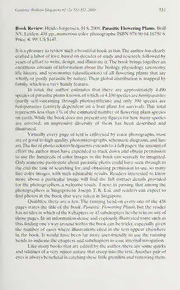
Parasitic Flowering Plants by H.S. Heide-Jørgensen PDF
Preview Parasitic Flowering Plants by H.S. Heide-Jørgensen
Gardens'Bulletin Singapore61 <2):551-552.2010 551 Book Review: Heide-j0rgensen. H S. 2008. Parasitic Flowering Plants. Brill NV, Leiden. 438 pp., numerous color photographs. ISBN 978 90 04 16750 6. Price:€ 99/ US$147. It is a pleasure to review such a beautiful book as this.The authorhas clearly crafted a labor oflove,based on decades ofstudy and research,followed by years ofeffort to write,design, and illustrate it.The book brings together an enormous amount of information about the biology, physiology, taxonomy, life history, and systematics (classification) of all flowering plants that are wholly or partly parasitic by nature.Their global distribution is mapped by family, which is a very handy feature. In total, the author estimates that there are approximately 4.490 species ofparasiticplants known,ofwhichca4.100species are hemiparasites (partly self-sustaining through photosynthesis) and only 390 species are holoparasites (entirely dependent on a host plant for survival). This total represents less than 1% ofthe estimated number offlowering plant species on earth.While the book does not present any figures for how many species are covered, an impressive diversity of them has been described and illustrated. Virtually every page of text is enlivened by color photographs, most are ofgood to high quality, photomicrographs, schematic diagrams, and line art.The list ofphoto acknowledgmentsextends to 4 full pages:the amount of effort the author must have expended to track down and obtain permission to use the hundreds of color images in the book can scarcely be imagined. Only someone passionate about parasitic plants could have seen through to the end the task of searching for. and obtaining permission to use. so many fine color images, with such admirable results. Readers interested to know more about a particular image will find the full contact details provided for the photographers, a welcome touch. I note, in passing, that among the photographers is Singaporean Joseph T. K. Lai. and readers can expect to find photos in the book that were taken in Singapore. Quibbles: there are a few.The running head on every one of the 438 pages states the title of the book. Parasitic Flowering Plants, but the reader hasno idea in which ofthe 8chaptersor43subchapters he/she isin on anyof those pages. In an information-dense and copiously illustrated tome such as this,finding one's way around within the book can be tricky,especially given the number of cases where illustrations cited in the text appear elsewhere in the book. It would have been far more user-friendly to use the running heads to indicate the chapters and subchapters to ease internal navigation. Like many books that are edited by the author, there are some quirks and oddities ofa very minor nature that creep into the text.Another pair of eyes is alwaysbeneficial in catching these little gremlins and removing them. 552 Garcl. Bull.Singapore61 (2)2010 For example, the state of New Jersey (in the USA) has consistently been rendered as "New Yersey" everywhere it occurs in text and photo captions. On the whole, however, typos are remarkably few and the text reads very well. The price is off-putting: like most books published by scientific and technical publishers, the price tag will deter many people from buying this magnificent book. It is to be hoped that Brill will produce a soft cover edition at a more economical price. Libraries, scientific institutes, and the serious student of parasitic plants will buy the hardcover edition, but the general public probably will not, purely for cost consideration. And that is a pity, because there is so much information contained in the book that will fascinate, educate, and delight anyone with an interest in the natural world. It is to be hoped that Singaporeans, and others in Southeas—t Asia generally, will splurge and indulge themselves by buying this book it has much to —offer.And all ofthe parasitic flowering plants native in ourpart o—fthe world Rafflesia, Striga, Balanophora, even a species of Lepionurus are to be found within its covers,which brings the information in this book very close to home. I can wholeheartedly offer my sincere congratulations to the author and publisher for bringing this comprehensive and beautiful work into existence; I believe it will be the standard of excellence on the subject of parasitic plants for decades to come. George Staples Senior Researcher The Herbarium Singapore Botanic Gardens
